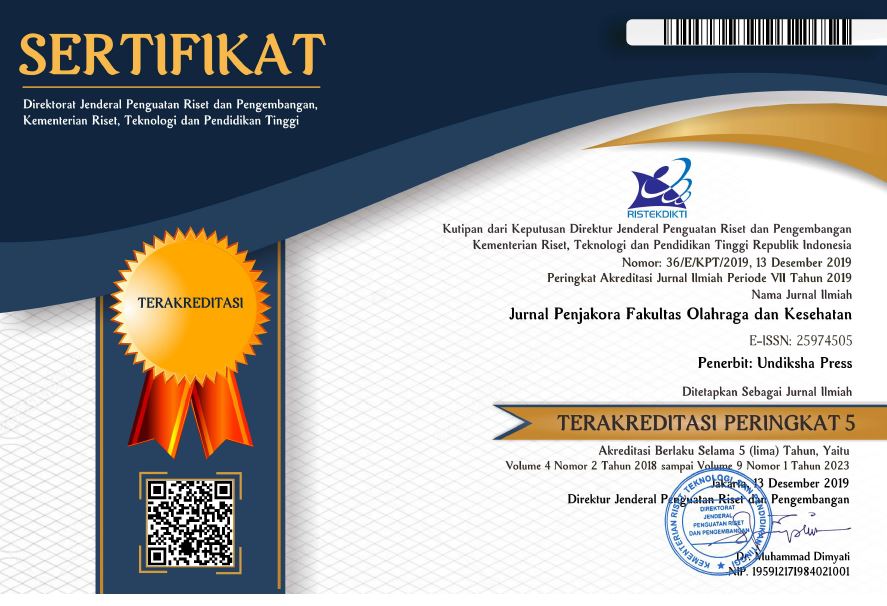Analisis Kuantitatif Faktor-Faktor Kohesi Dalam Tim Olahraga Anak-Anak: Implikasi Praktis Dalam Pendidikan Olahraga
DOI:
https://doi.org/10.23887/jurnalpenjakora.v11i1.74212Keywords:
kohesi, olahraga, anak-anakAbstract
Tujuan Penelitian ini adalah untuk menganalisis faktor-faktor kohesi dalam tim olahraga yaitu dengan mengukur dua aspek perbandingan (sosial item, task item atau tugas individual) dalam olahraga dan mengetahui perbedaan tingkat partisipasi olahraga antara siswa yang berada di wilayah perkotaan dengan pedesaan. Metode penelitian yang dilakukan menggunakan pendekatan deskriptif kuantitatif dengan studi analitik cross sectional. Populasi yang digunakan sebanyak 80 siswa usia (9-12 tahun) dengan keahlian olahraga dibidang tertentu dan bertempat tinggal di wilayah kota maupun desa. Hasil menunjukkan bahwa (1) hasil rata-rata keseluruhan siswa kota dengan desa sebesar 82,7% di indikator sangat baik; (2) hasil rata-rata siswa kota sebesar 82,64% dan rata-rata siswa desa sebesar 80,06%. Hal ini menunjukkan bahwa tidak ada perbedaan yang signifikan antara siswa kota dengan desa, keduanya berada pada indikator sangat baik.
References
Arikunto, S. (2010). Prosedur Penelitian: Suatu Pendekatan Praktik. Rineka Cipta.
Basturkmen, H., & Von Randow, J. (2014). Guiding the reader (or not) to re-create coherence: Observations on postgraduate student writing in an academic argumentative writing task. Journal of English for Academic Purposes, 16, 14–22.
Bean, R. A., Barber, B. K., & Crane, D. R. (2006). Parental support, behavioral control, and psychological control among African American youth: The relationships to academic grades, delinquency, and depression. Journal of Family Issues, 27(10), 1335–1355.
Chen, J. (2008). An investigation of EFL students’ use of cohesive devices. Asia Pacific Education Review, 5(2), 215–225.
Crossley, S. A., Kyle, K., & McNamara, D. S. (2016). The development and use of cohesive devices in L2 writing and their relations to judgments of essay quality. Journal of Second Language Writing, 32, 1–16.
Dastjerdi, H. V., & Samian, S. H. (2011). Quality of Iranian EFL learners’ argumentative essays: Cohesive devices in focus. Mediterranean Journal of Social Sciences, 2(2), 65–76.
Derewianka, B., & Jones, P. (2016). Teaching language in context. ERIC.
Eggins, S. (2004). Introduction to systemic functional linguistics. A&c Black.
Emilia, E. (2014). Introducing functional grammar. Bandung: Pustaka Jaya.
Formoso, D., Gonzales, N. A., & Aiken, L. S. (2000). Family conflict and children’s internalizing and externalizing behavior: Protective factors. American Journal of Community Psychology, 28(2), 175–199.
Gumantan, A., & Mahfud, I. (2018). Perbandingan Latihan Dengan Menggunakan Bola Ukuran 4 dan 5 Terhadap Ketepatan Menendang Bola ke Arah Gawang. Journal of SPORT (Sport, Physical Education, Organization, Recreation, and Training), 2(1), 1–7.
Hariadi, S. S. (2011). Dinamika kelompok: teori dan aplikasinya untuk analisis keberhasilan kelompok tani sebagai unit belajar, kerjasama, produksi, dan bisnis. Sekolah Pascasarjana, Universitas Gadjah Mada.
Kliewer, W., Murrelle, L., Prom, E., Ramirez, M., Obando, P., Sandi, L., & del Carmen Karenkeris, M. (2006). Violence exposure and drug use in Central American youth: Family cohesion and parental monitoring as protective factors. Journal of Research on Adolescence, 16(3), 455–478.
Kusumah, R. G. T., Walid, A., Pitaloka, S., Dewi, P. S., & Agustriana, N. (2020). Penerapan Metode Inquiry Sebagai Usaha Untuk Meningkatkan Hasil Belajar IPA Pada Materi Penggolongan Hewan Di Kelas IV SD Seluma. Jurnal Pendidikan Matematika Dan IPA, 11(1), 142–153.
Lamborn, S. D., & Felbab, A. J. (2003). Applying ethnic equivalence and cultural values models to African-American teens’ perceptions of parents. Journal of Adolescence, 26(5), 601–618.
Lee, I. (2002). Teaching coherence to ESL students: A classroom inquiry. Journal of Second Language Writing, 11(2), 135–159.
Meinarno, E. A., & Sarwono, S. W. (2018). Psikologi Sosial. Salemba Humanika.
Nugroho, R. A., & Gumantan, A. (2020). Pengaruh Latihan Plyometric Terhadap Peningkatan Kemampuan Vertical Jump Peserta Kegiatan Ekstrakurikuler Bolabasket Sman 1 Pagelaran. Sport Science And Education Journal, 1(1).
Ong, J. (2011). Investigating the use of cohesive devices by Chinese EFL learners. The Asian EFL Journal Quarterly, 11(3), 42–65.
Risthantri, P., & Sudrajat, A. (2015). Hubungan antara pola asuh orang tua dan ketaatan beribadah dengan perilaku sopan santun peserta didik. Harmoni Sosial: Jurnal Pendidikan IPS, 2(2), 191–202.
Sadighi, F., & Heydari, P. (2012). Cohesion analysis of L2 writing: The case of Iranian undergraduate EFL learners. Mediterranean Journal of Social Sciences, 3(2), 557–573.
Sanczyk, A. (2010). Investigating argumentative essays of English undergraduates studying in Poland as regards their use of cohesive devices.
Sandika, A., & Mahfud, I. (2021). Penerapan Model Latihan Daya Tahan Kardiovaskuler With the Ball Permainan Sepak Bola Ssb Bu Pratama. Journal Of Physical Education, 2(1), 32–36.
Santoso, S. (2011). SPSS mengolah data statistik secara profesional. PT Elex Media Komputindo.
Witte, S. P., & Faigley, L. (2003). Coherence, cohesion, and writing quality. Cross-Talk in Comp Theory: A Reader. Revised and Updated., 245.
Wulantina, E., & Maskar, S. (2019). Pembelajaran Matematika Berbasis Lampungnese Etnomatematics Pada Materi Bangun Datar. Prosiding Seminar Nasional Pendidikan FKIP Universitas Lampung Tahun, 793.
Zhang, W., & Fuligni, A. J. (2006). Authority, autonomy, and family relationships among adolescents in urban and rural China. Journal of Research on Adolescence, 16(4), 527–537.
Downloads
Published
Issue
Section
License
Copyright (c) 2024 Dani Permana, Didin Budiman, Anira, Wulandari Putri

This work is licensed under a Creative Commons Attribution-ShareAlike 4.0 International License.
Authors who publish with the JURNAL PENJAKORA agree to the following terms:
- Authors retain copyright and grant the journal the right of first publication with the work simultaneously licensed under a Creative Commons Attribution License (CC BY-SA 4.0) that allows others to share the work with an acknowledgment of the work's authorship and initial publication in this journal.
- Authors are able to enter into separate, additional contractual arrangements for the non-exclusive distribution of the journal's published version of the work (e.g., post it to an institutional repository or publish it in a book), with an acknowledgment of its initial publication in this journal.
- Authors are permitted and encouraged to post their work online (e.g., in institutional repositories or on their website) prior to and during the submission process, as it can lead to productive exchanges, as well as earlier and greater citation of published work. (See The Effect of Open Access)







